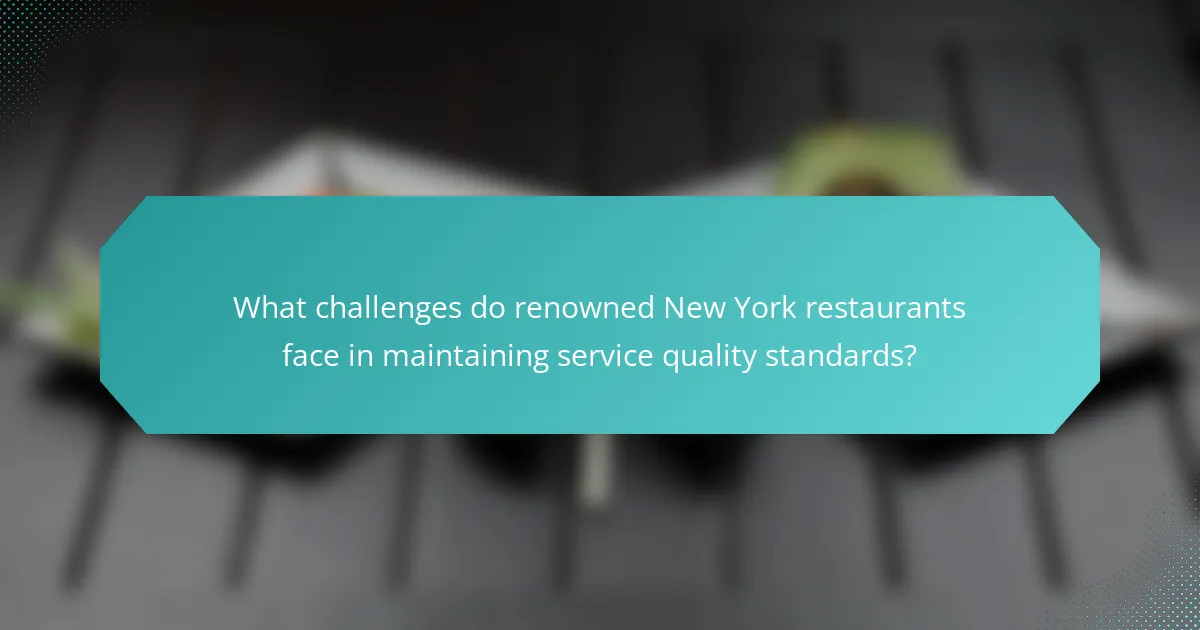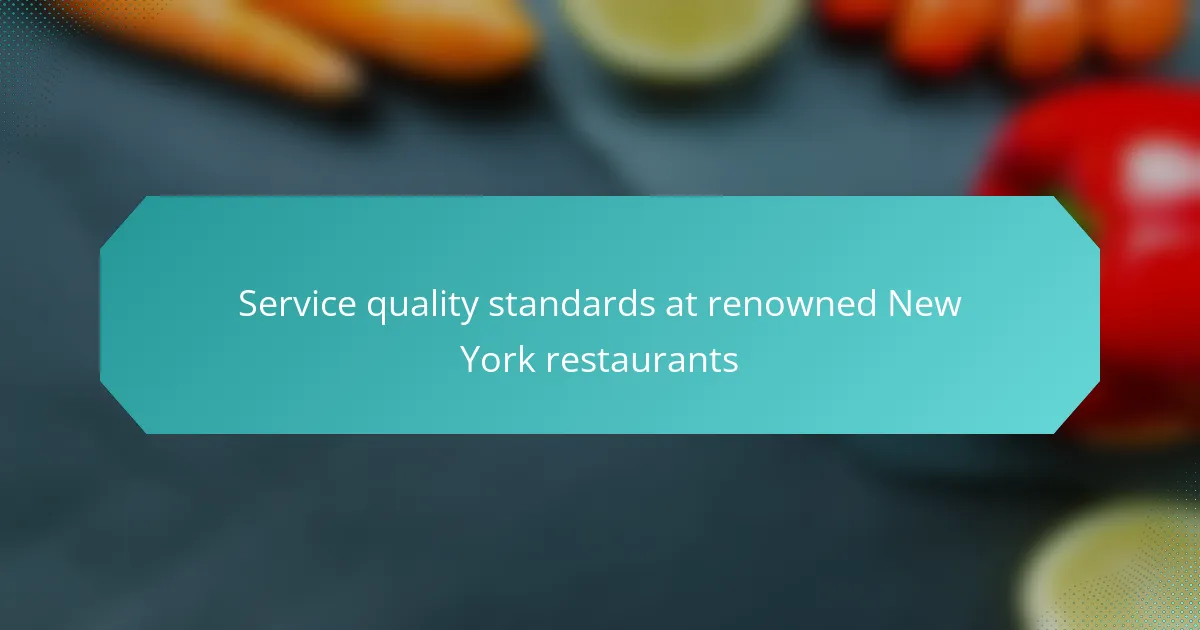Service quality standards at renowned New York restaurants are crucial for delivering exceptional dining experiences. These standards encompass attentive and knowledgeable staff, prompt service, cleanliness, and a welcoming ambiance. High-end establishments, particularly Michelin-starred restaurants, prioritize personalized service and rigorous staff training to meet high customer expectations. Challenges such as staffing shortages, fluctuating food costs, and seasonal tourism impact the consistency of service quality. Additionally, customer feedback plays a significant role in shaping these standards, as restaurants adapt to meet diverse guest preferences while maintaining their unique brand identity.

What are the service quality standards at renowned New York restaurants?
Renowned New York restaurants maintain high service quality standards. These standards include attentive and knowledgeable staff. Servers should be able to answer menu questions expertly. Timeliness is crucial; guests expect prompt seating and service. Cleanliness and ambiance also play significant roles in the overall dining experience. Many top restaurants focus on personalized service to enhance guest satisfaction. Additionally, staff training is essential to uphold these standards consistently. According to the Michelin Guide, service quality is a key factor in restaurant ratings.
How are service quality standards defined in the restaurant industry?
Service quality standards in the restaurant industry are defined by specific criteria that ensure customer satisfaction. These criteria include food quality, service speed, staff professionalism, and cleanliness. Food quality refers to the taste, presentation, and freshness of the dishes served. Service speed measures how quickly customers receive their orders. Staff professionalism involves the demeanor, knowledge, and responsiveness of the waitstaff. Cleanliness encompasses the overall hygiene of the dining area and restrooms.
Research indicates that restaurants with high service quality standards tend to have higher customer retention rates. According to a study by the National Restaurant Association, 70% of diners return to restaurants that provide excellent service. This data underscores the importance of maintaining defined service quality standards in the restaurant industry.
What key attributes characterize high service quality in restaurants?
High service quality in restaurants is characterized by attentiveness, responsiveness, and professionalism. Attentiveness involves staff being aware of customer needs without being intrusive. Responsiveness refers to the ability to address customer requests promptly and effectively. Professionalism includes the staff’s knowledge of the menu and ability to communicate clearly. Consistency in service delivery is also crucial, ensuring that every customer receives the same high level of service. Additionally, a welcoming atmosphere enhances the overall dining experience. Studies show that positive service experiences significantly impact customer satisfaction and repeat business.
How do these attributes vary among different types of restaurants?
Attributes such as service speed, menu diversity, and customer interaction vary significantly among different types of restaurants. Fast-food restaurants prioritize quick service and limited menu options. They often employ standardized processes to ensure efficiency. Casual dining establishments offer a wider menu and focus on a relaxed atmosphere. Their service tends to be more personalized than fast food. Fine dining restaurants emphasize high-quality service and extensive menus. They often provide detailed customer interaction and an upscale dining experience. According to a 2022 survey by the National Restaurant Association, 70% of diners prefer personalized service in casual and fine dining compared to fast food. This highlights how service quality standards are tailored to the restaurant type.
Why are service quality standards important for restaurants in New York?
Service quality standards are crucial for restaurants in New York to ensure customer satisfaction and loyalty. High standards lead to positive dining experiences, which are essential in a competitive market. New York’s restaurant scene is diverse and fast-paced. Customers expect exceptional service due to the city’s reputation. According to a survey by the National Restaurant Association, 70% of diners consider service quality a key factor in their dining choices. Consistently meeting service standards helps restaurants build a strong reputation. This reputation attracts new customers and retains existing ones. Consequently, service quality directly impacts profitability and long-term success.
What impact do service quality standards have on customer satisfaction?
Service quality standards significantly influence customer satisfaction. High service quality standards lead to positive customer experiences. Customers expect consistent and reliable service. When standards are met, customers feel valued and appreciated. This results in increased loyalty and repeat business. Research indicates that 70% of customers base their satisfaction on service quality. In renowned New York restaurants, maintaining high service standards is crucial for success. These establishments often receive higher ratings when service quality is prioritized. Consequently, effective service quality standards directly correlate with enhanced customer satisfaction levels.
How do service quality standards influence restaurant reputation?
Service quality standards significantly influence restaurant reputation. High service quality leads to positive customer experiences. Satisfied customers are more likely to leave favorable reviews. Positive reviews enhance a restaurant’s visibility and attract new patrons. Conversely, poor service can result in negative feedback. Negative feedback damages a restaurant’s reputation and deters potential customers. Research shows that 70% of consumers trust online reviews as much as personal recommendations. This highlights the impact of service quality on reputation.
What are some common service quality standards observed in New York restaurants?
Common service quality standards observed in New York restaurants include promptness, attentiveness, and professionalism. Restaurants prioritize quick service to enhance customer satisfaction. Attentiveness involves staff being responsive to customer needs without being intrusive. Professionalism is reflected in staff appearance and behavior. Many establishments adhere to these standards to maintain a competitive edge in a bustling dining scene. According to a 2020 survey by the New York State Restaurant Association, 85% of diners consider service quality crucial to their overall experience.
How do renowned New York restaurants implement these standards?
Renowned New York restaurants implement service quality standards through rigorous training and consistent evaluation. Staff undergo extensive training programs focusing on customer service excellence. These programs often include role-playing scenarios and feedback sessions. Restaurants utilize mystery shoppers to assess service performance regularly. They also gather customer feedback through surveys to identify areas for improvement. Many establishments set specific performance metrics to track service quality. High standards are maintained by promoting a culture of accountability among staff. This approach ensures that service quality aligns with the restaurant’s reputation and customer expectations.
What role does staff training play in maintaining service quality?
Staff training is essential for maintaining service quality in restaurants. It equips employees with the necessary skills and knowledge to perform their tasks effectively. Well-trained staff can provide better customer service, leading to increased customer satisfaction. Training programs often cover areas such as communication, menu knowledge, and problem-solving. According to a study by the National Restaurant Association, restaurants that invest in employee training report higher customer satisfaction scores. This correlation highlights the importance of ongoing training in fostering a positive dining experience. Additionally, trained employees are more likely to adhere to service standards, ensuring consistency across the establishment.

How do service quality standards differ among various renowned New York restaurants?
Service quality standards vary significantly among renowned New York restaurants. High-end establishments often emphasize personalized service and attention to detail. For instance, Michelin-starred restaurants typically train staff extensively to ensure exceptional guest experiences. In contrast, casual dining venues may prioritize efficiency and speed over personalized interactions.
Moreover, fine dining restaurants frequently implement rigorous service protocols. These include specific guidelines for table settings, timing of courses, and staff attire. A study by the Cornell University School of Hotel Administration highlights that luxury restaurants focus on creating a memorable dining atmosphere.
Additionally, customer feedback influences service standards. Restaurants like Eleven Madison Park adapt their service based on guest reviews and preferences. This responsiveness can lead to variations in service quality even within the same category of dining. Overall, service quality standards are shaped by the restaurant’s concept, target audience, and operational philosophy.
What are the unique service quality standards of fine dining establishments?
Fine dining establishments maintain unique service quality standards that differentiate them from other dining experiences. These standards include exceptional attention to detail, personalized service, and a high level of professionalism. Staff members are often trained extensively in etiquette and food knowledge. The ambiance is meticulously curated to enhance the dining experience.
Menu offerings frequently feature high-quality, seasonal ingredients, often prepared using advanced culinary techniques. Presentation of dishes is an art form, emphasizing aesthetics as much as flavor. Additionally, fine dining restaurants typically provide a well-curated wine list, with staff trained to make informed pairings.
Customer feedback is actively sought and valued, leading to continuous improvement in service quality. These attributes collectively create a distinctive dining experience that is expected in fine dining establishments.
How do these standards enhance the dining experience?
Service quality standards enhance the dining experience by ensuring consistency and excellence in food and service. These standards establish clear expectations for staff behavior and food preparation. Consistent service leads to customer satisfaction and repeat visits. High standards also improve food quality, using fresh ingredients and skilled techniques. This results in a memorable culinary experience. Additionally, well-trained staff provide knowledgeable recommendations, enhancing guest engagement. Research shows that restaurants with high service standards see increased customer loyalty and positive reviews. For example, a study by the Cornell University School of Hotel Administration found that service quality directly correlates with customer satisfaction and retention.
What specific training do staff undergo in fine dining restaurants?
Fine dining restaurant staff undergo extensive training in various areas. This training includes service etiquette, wine knowledge, and menu comprehension. Staff learn to provide exceptional customer service and to anticipate guest needs. They are trained in proper table settings and dining protocols. Additionally, staff receive training in food safety and hygiene practices. Many fine dining establishments emphasize teamwork and communication skills. Role-playing scenarios are often used to simulate real dining experiences. This comprehensive training ensures high service quality standards are consistently met.
How do casual dining restaurants approach service quality standards?
Casual dining restaurants approach service quality standards by emphasizing consistency, attentiveness, and a welcoming atmosphere. They train staff to provide friendly and prompt service. Employees are often encouraged to engage with customers to enhance their dining experience. Menu knowledge is crucial for staff to answer questions and make recommendations. Casual dining establishments also gather customer feedback to improve service. They implement standard operating procedures to ensure uniformity across locations. Additionally, they may use mystery diners to assess service quality. This focus on service quality contributes to customer satisfaction and repeat business.
What are the key differences in service expectations compared to fine dining?
Casual dining typically has less formal service expectations compared to fine dining. In casual dining, the service is often more relaxed and informal. Staff may not provide the same level of personalized attention as in fine dining. The pace of service is generally quicker in casual settings. Guests may order at the counter rather than having a dedicated server. In fine dining, the staff is trained to provide detailed menu knowledge and wine pairing suggestions. Fine dining establishments also focus on a higher staff-to-guest ratio for attentive service. These differences reflect the overall dining experience and atmosphere that each type of restaurant aims to create.
How do casual dining establishments maintain customer engagement?
Casual dining establishments maintain customer engagement through various strategies. They offer loyalty programs that reward repeat visits, enhancing customer retention. Engaging menus with seasonal offerings keep the dining experience fresh and exciting. Social media interactions allow establishments to connect with customers outside the restaurant. Regular events, such as live music or themed nights, attract customers and create a community atmosphere. Personalized service enhances the overall experience, making customers feel valued. Surveys and feedback mechanisms help establishments understand customer preferences and improve service. According to a study by the National Restaurant Association, 76% of consumers are more likely to return to a restaurant that engages with them online.
What service quality standards are emphasized in fast-casual restaurants?
Fast-casual restaurants emphasize several key service quality standards. These include speed of service, accuracy of orders, and customer service friendliness. Fast-casual dining typically aims for a quick turnaround time, often under 10 minutes for food preparation. Order accuracy is crucial, as mistakes can lead to customer dissatisfaction. Staff members are trained to be approachable and helpful, enhancing the overall dining experience. Cleanliness is also a critical standard, as it reflects the restaurant’s commitment to hygiene and quality. Additionally, ambiance plays a role, creating a comfortable environment for diners. These standards are essential for maintaining customer loyalty and satisfaction in a competitive market.
How do these standards cater to a different customer demographic?
Service quality standards at renowned New York restaurants cater to different customer demographics by tailoring experiences to specific preferences. These standards include personalized service, menu diversity, and ambiance adjustments. For instance, fine dining establishments often emphasize formal service for affluent customers. Conversely, casual dining places may focus on a more relaxed atmosphere for families or younger crowds.
Moreover, restaurants often adapt their menus to reflect dietary trends, attracting health-conscious patrons. Statistics show that 60% of millennials prefer restaurants offering vegan options. By implementing these standards, restaurants can effectively engage various customer groups, enhancing satisfaction and loyalty.
What role does speed of service play in fast-casual settings?
Speed of service is crucial in fast-casual settings as it directly impacts customer satisfaction and repeat business. Quick service meets the expectations of customers who seek convenience and efficiency. A study by the National Restaurant Association indicates that 70% of diners prefer establishments that serve food quickly. Fast-casual restaurants often emphasize speed to differentiate themselves from traditional dining options. The operational model typically includes streamlined processes and pre-prepared ingredients, enhancing service speed. In a competitive market, faster service can lead to increased table turnover and higher revenue. Thus, speed of service is a key factor in the success of fast-casual dining experiences.

What challenges do renowned New York restaurants face in maintaining service quality standards?
Renowned New York restaurants face several challenges in maintaining service quality standards. High customer expectations are a primary challenge. Diners often seek exceptional experiences due to the city’s reputation. Staffing issues also complicate service consistency. Finding skilled workers in a competitive market can be difficult. Additionally, fluctuating food costs affect quality. Restaurants must balance quality ingredients with budget constraints.
Seasonal tourism impacts service demand unpredictably. Increased foot traffic can overwhelm staff and resources. Lastly, maintaining a unique brand identity while meeting diverse customer needs is complex. Restaurants must adapt to changing trends without losing their core values.
What are the common obstacles to achieving high service quality?
Common obstacles to achieving high service quality include staff training deficiencies, inconsistent service delivery, and inadequate communication. Staff training deficiencies lead to unprepared employees. Unprepared employees struggle to meet customer expectations. Inconsistent service delivery creates variability in customer experiences. This variability can result in customer dissatisfaction. Inadequate communication between staff and management hampers service efficiency. Poor communication can lead to misunderstandings and errors. Additionally, high employee turnover disrupts service continuity. Disrupted continuity affects the overall customer experience negatively. These obstacles collectively hinder the establishment of high service quality in renowned New York restaurants.
How do staffing shortages affect service quality in restaurants?
Staffing shortages significantly degrade service quality in restaurants. With fewer staff members, customer wait times increase. This leads to longer delays in food preparation and order fulfillment. Customers may experience reduced attention from servers. Consequently, overall dining satisfaction diminishes. Research indicates that restaurants with adequate staffing see higher customer retention rates. A study by the National Restaurant Association found that 75% of diners prioritize service quality. Insufficient staffing can also lead to errors in orders. These factors collectively harm a restaurant’s reputation and profitability.
What strategies can restaurants employ to overcome these challenges?
Restaurants can employ several strategies to overcome challenges in service quality standards. First, they can invest in staff training programs. These programs enhance employee skills and improve customer interactions. Second, implementing customer feedback systems can identify areas needing improvement. Regularly collecting and analyzing feedback helps restaurants adapt to customer preferences. Third, utilizing technology can streamline operations. Online reservation systems and mobile ordering enhance efficiency and customer experience. Fourth, maintaining high standards in food quality is crucial. Consistent ingredient sourcing and preparation standards ensure customer satisfaction. Lastly, fostering a positive work environment can boost employee morale. Happy employees are more likely to provide excellent service.
How do customer expectations impact service quality standards?
Customer expectations significantly influence service quality standards. High customer expectations lead restaurants to enhance their service offerings. This often results in improved training for staff and better service protocols. For instance, if customers expect prompt service, restaurants may implement stricter time management practices. Research shows that 70% of customers are willing to pay more for better service. This correlation drives restaurants to set higher service standards. Additionally, consistent feedback from customers helps restaurants adjust their quality standards. This creates a dynamic environment where service quality evolves based on customer input.
What trends are influencing customer expectations in New York restaurants?
Customer expectations in New York restaurants are influenced by several key trends. The rise of health-conscious dining has shifted preferences towards organic and locally sourced ingredients. Consumers increasingly demand transparency regarding food sourcing and preparation methods. Additionally, the growing popularity of plant-based options reflects a shift in dietary preferences. Technology integration, such as mobile ordering and contactless payment, is also reshaping dining experiences. Furthermore, personalized service and unique dining experiences are becoming essential for customer satisfaction. A survey by the National Restaurant Association indicates that 70% of diners prioritize restaurants that offer sustainable practices. These trends collectively shape the evolving landscape of customer expectations in New York’s dining scene.
How can restaurants adapt to changing customer preferences?
Restaurants can adapt to changing customer preferences by regularly updating their menus. They should incorporate seasonal ingredients to enhance freshness and appeal. Engaging with customers through surveys can provide valuable insights into their desires. Implementing dietary options, such as vegan or gluten-free dishes, meets diverse needs.
Utilizing social media allows restaurants to gauge trends and customer feedback in real-time. Training staff to understand and respond to customer preferences improves service quality. Collaborating with local suppliers can enhance the menu’s appeal while supporting the community.
According to a National Restaurant Association report, 60% of consumers are more likely to visit a restaurant that offers locally sourced ingredients. This shows how adapting to preferences can drive customer loyalty and increase foot traffic.
What best practices can restaurants adopt to enhance service quality standards?
Restaurants can enhance service quality standards by implementing staff training programs. Regular training ensures employees are knowledgeable about menu items and service protocols. Additionally, adopting a customer feedback system allows restaurants to gather insights for improvement. Using technology, such as reservation and ordering systems, can streamline operations and enhance the customer experience. Establishing clear communication channels among staff promotes teamwork and efficiency. Maintaining cleanliness and ambiance directly impacts customer satisfaction. According to a study by the National Restaurant Association, 70% of customers return due to positive service experiences. These practices contribute to a consistent and high-quality dining experience.
How can feedback mechanisms improve service quality?
Feedback mechanisms can significantly enhance service quality by providing businesses with direct insights from customers. These mechanisms, such as surveys and reviews, enable restaurants to identify areas needing improvement. For instance, a 2021 study found that restaurants implementing regular feedback loops saw a 20% increase in customer satisfaction scores. By analyzing feedback, management can address specific concerns, such as wait times or staff behavior. This proactive approach leads to better training and service adjustments. Ultimately, effective feedback mechanisms create a responsive environment that aligns service delivery with customer expectations.
What role do technology and innovation play in enhancing service quality?
Technology and innovation significantly enhance service quality in renowned New York restaurants. They streamline operations, reduce wait times, and improve customer interactions. For example, many restaurants use reservation systems that optimize table management. This leads to a smoother dining experience for guests. Additionally, mobile ordering apps allow customers to place orders in advance. This convenience enhances customer satisfaction and reduces in-restaurant congestion.
Moreover, advanced kitchen technology improves food preparation efficiency. This results in faster service and consistent food quality. According to a 2020 study by the National Restaurant Association, 70% of diners prefer restaurants that utilize technology to enhance their experience. This statistic underscores the importance of integrating innovative solutions in the dining sector. Overall, technology and innovation are crucial for maintaining high service quality standards in competitive environments.
Service quality standards at renowned New York restaurants are critical for ensuring customer satisfaction and loyalty. These standards encompass attributes such as attentiveness, professionalism, and cleanliness, which are essential for creating positive dining experiences. The article explores how these standards are defined and implemented across various restaurant types, including fine dining, casual, and fast-casual establishments. Additionally, it discusses the impact of service quality on restaurant reputation and customer retention, as well as the challenges faced in maintaining high standards in a competitive market. Key strategies for enhancing service quality, including staff training and the integration of technology, are also examined.
